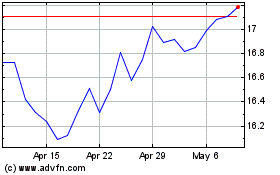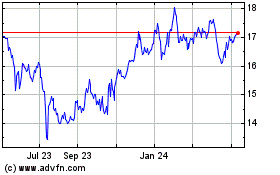Dish Offers Its Services to Military's Proposed 5G Network Project
November 01 2020 - 5:27PM
Dow Jones News
By Drew FitzGerald
The telecom industry turned out in force to oppose a recent
Pentagon proposal to build a shared fifth-generation wireless
network, with a familiar pot-stirrer making an exception: Dish
Network Corp.
The satellite-TV company last week submitted a list of
suggestions for the Department of Defense, which is exploring 5G
technology for its own operations. The Colorado company said its
under-construction cellular network could meet many of the criteria
that the military is considering while also serving private-sector
interests.
"There is a precedent for how the DoD can take advantage of
shared physical assets and network resources, while maintaining
operational control and flexibility to support the DoD's
objectives," Dish wrote in its filing, citing satellites that
handle commercial and military clients and the FirstNet
public-safety network run by AT&T Inc.
It is unclear how receptive the military will be to the
scenarios outlined by Dish, which is controlled by billionaire
co-founder Charlie Ergen. The Defense Department issued a request
for information in September, a first step toward soliciting bids
from contractors.
The request dangled a prize far more valuable than a standard
defense contract: access to up to 450 megahertz of radio
frequencies currently used for military radar systems.
Telecom-industry analysts say exclusive rights to such a wide swath
of frequencies would fetch tens of billions of dollars if they were
sold on the open market.
Cellphone carriers such as AT&T, Verizon Communications Inc.
and T-Mobile US Inc. have already spent billions of dollars to
acquire spectrum licenses that guarantee their customers a clean
signal. Dish has spent more than $21 billion to amass its own
reserved frequencies.
Dish hasn't yet installed most of the cellular antennae, radio
base stations and fiber-optic lines needed to run its network,
which will cost an estimated $10 billion to build. A single defense
contract wouldn't foot the whole bill, but partnering with the
federal government could pay for some capital expenses while giving
Mr. Ergen's company the credibility it needs to attract other
corporate customers.
The Federal Communications Commission usually handles the
assignment of radio spectrum to commercial operators. The latest
Pentagon proposal could bypass that traditional process by
maintaining the Defense Department's title over the airwaves, which
are used today for early-warning radar systems and other military
equipment, while commercial operators lease the asset to connect
cellphones, smart vehicles and other 5G devices.
Other telecom companies said the Defense Department's trial
balloon could interfere with a commercial model that has worked
well in the past.
AT&T policy executive Joan Marsh said a wholesale or leasing
model would fail to deliver the benefits its proponents promise.
"There is simply no reason to take a gamble and rush through an
unproven and barely tested change of course now," she added.
Verizon said a Defense Department project to select commercial
operators would overstep the bounds of what Congress authorized it
to do with its spectrum. "There is no legal authority for DoD to
launch such an approach," the company wrote in a filing reviewed by
The Wall Street Journal.
Dish's October filing likewise opposed "any proposal to create a
nationalized, government-owned and operated 5G network" as an
inefficient use of resources. But the company went on to detail how
the military could use Dish's cellular-tower equipment and software
to run its own wireless network.
Dish has benefited in the past from federal policy compromises.
In 2018, the company urged the federal government to block
T-Mobile's proposed merger with then-rival Sprint Corp. while
hinting that a different deal structure could sway its stance.
Mr. Ergen's company threw its support behind the merger after
the U.S. Justice Department demanded that the carriers divest some
assets to Dish, ensuring a fourth competitor in the market for
wireless services. Dish took control of Sprint's Boost Mobile
business, along with other divested assets, in July.
Write to Drew FitzGerald at andrew.fitzgerald@wsj.com
(END) Dow Jones Newswires
November 01, 2020 17:12 ET (22:12 GMT)
Copyright (c) 2020 Dow Jones & Company, Inc.
AT&T (NYSE:T)
Historical Stock Chart
From Aug 2024 to Sep 2024

AT&T (NYSE:T)
Historical Stock Chart
From Sep 2023 to Sep 2024
